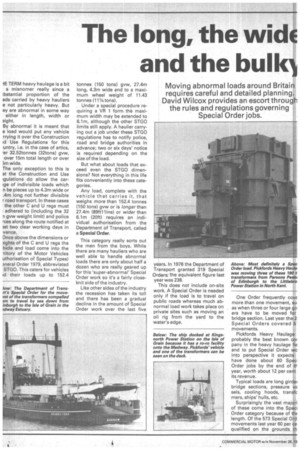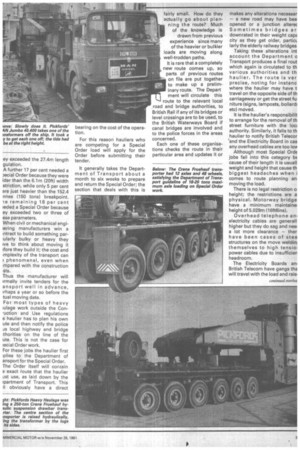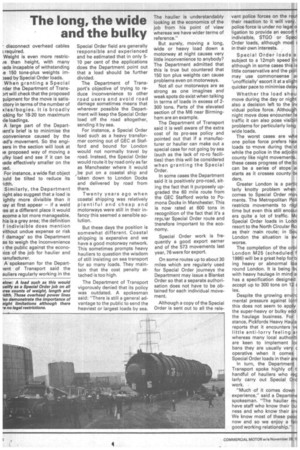The long, the with and the bulks
Page 28

Page 29

Page 30

If you've noticed an error in this article please click here to report it so we can fix it.
Moving abnormal loads around Britain requires careful and detailed planning. David Wilcox provides an escort through the rules and regulations governing Special Order jobs.
1E TERM heavy haulage is a bit a misnomer really since a lbstantial proportion of the ads carried by heavy hauliers e not particularly heavy. But ey are abnormal in some way either in length, width or aight.
By abnormal it is meant that e load would put any vehicle rrying it over the Construction id Use Regulations for this untry, i.e. in the case of artics, 'er 32.52tonnes (32tons) gvw, over 15m total length or over im wide.
The only exception to this is at the Construction and Use !gulations do allow the carige of indivisible loads which n be pieces up to 4.3m wide or .4m long not further divisible r road transport. In these cases the other C and U regs must adhered to (including the 32 gvw weight limit) and police rces along the route notified at ;st two clear working days in vance.
Once above the dimensions or ;ights of the C and U regs the hide and load come into the -ritory of the Motor Vehicles uthorisation of Special Types) aneral Order 1979, abbreviated STGO. This caters for vehicles id their loads up to 152.4
tonnes (150 tons) gvw, 27.4m long, 4.3m wide and to a maximum wheel weight of 11.43 tonnes (111/4 tons).
Under a special procedure requiring a VR 1 form the maximum width may be extended to 6.1m, although the other STGO limits still apply. A haulier carrying out a job under these STGO regulations has to notify police, road and bridge authorities in advance; two or six days' notice is required depending on the size of the load.
But what about loads that exceed even the STGO dimensions? Not everything in this life fits conveniently into these categories.
Any load, complete with the vehicle that carries it, that weighs more than 152.4 tonnes (150 tons) gvw or is longer than 27.4m (89ft11ins) or wider than 6.1m (20ft) requires an individual authorisation from the Department of Transport, called a Special Order.
This category really sorts out the men from the boys. While there are many hauliers who are well able to handle abnormal loads there are only about half a dozen who are really geared up for this 'super-abnormal' Special Order work so it's a fairly closeknit side of the industry.
Like other sides of the industry the recession has taken its toll and there has been a gradual decline in the amount of Special Order work over the last five years. In 1976 the Department of Transport granted 319 Special Orders; the equivalent figure last year was 238.
This does not include on-site work. A Special Order is needed only if the load is to travel on public roads whereas much abnormal load work takes place on private sites such as moving an oil rig from the yard to the water's edge.
One Order frequently COVE more than one movement, su as when three or four large gir ers have to be moved for bridge section. Last year the 2 Special Orders covered 5movements.
Pickfords Heavy Haulage probably the best known CO! pany in the heavy haulage fie and to put Special Order we into perspective it expects have done about 60 Spec Order jobs by the end of year, worth about 12 per cent its revenue.
Typical loads are long girder bridge sections, pressure ve sels, cooling hoods, transfc mers, ships' hulls, etc.
Surprisingly the vast majori of these come into the Spedi Order category because of thE length. Of the 573 Special Ord movements last year 60 per ce qualified on the grounds th ey exceeded the 27.4m length gulation.
A further 17 per cent needed a )ecial Order because they were ider than the 6.1m (20ft) width striction, while only 5 per cent are just heavier than the 1514 nnes (150 tons) breakpoint. -le remaining 18 per cent reded a Special Order because ey exceeded two or three of ese parameters.
When civil or mechanical engi:ering manufacturers win a .ntract to build something par:ularly bulky or heavy they ive to think about moving it rfore they build it; the cost and Implexity of the transport can phenomenal, even when mpared with the construction sts.
Thus the manufacturer will rrmally invite tenders for the ansport well in advance, Irhaps a year or so before the tual moving date.
For most types of heavy lulage work outside the Con-uction and Use regulations a haulier has to plan his own ute and then notify the police Js local highway and bridge thorities on the line of the ute. This is not the case for recial Order work.
For these jobs the haulier first 'plies to the Department of ansport for the Special Order. The Order itself will contain a exact route that the haulier JSt use, as laid down by the :partment of Transport. This II obviously have a direct For this reason hauliers who are competing for a Special Order load will apply for the Order before submitting their tender.
It generally takes the Department of Transport about a month to six weeks to prepare and return the Special Order; the section that deals with this is fairly small. How do they actually go about planning the route? Much of the knowledge is drawn from previous experience since many of the heavier or bulkier loads are moving along well-trodden paths.
It is rare that a completely new route comes up, so parts of previous routes on file are put together to make up a preliminary route. The Depart ment will circulate this route to the relevant local road and bridge authorities, to British Rail if any of its bridges or level crossings are to be used, to the British Waterways Board if canal bridges are involved and to the police forces in the areas concerned.
Each one of these organisations checks the route in their particular area and updates it or makes any alterations necessar — a new road may have bee opened or a junction alterec Sometimes bridges at downrated in their weight capE city as they get older, partict. larly the elderly railway bridges Taking these alterations int account the Department o Transport produces a final rout which again is circulated to th various authorities and th haulier. The route is vet precise, noting for instanc where the haulier may have t travel on the opposite side of th carriageway or get the street fu niture (signs, lamposts, bollard: etc) moved.
It is the haulier's responsibilit to arrange for the removal of th street furniture with the loci authority. Similarly, it falls to th haulier to notify British Telecor 'and the Electricity Board in cas any overhead cables are too lov Although most Special OrdE jobs fall into this category IDE cause of their length it is usuall weight and height that cause th biggest headaches when i comes to route planning an moving the load.
There is no legal restriction o height; the restrictions are a physical. Motorway bridge have a minimum maintainei height of 5.029m (16ft6ins).
Overhead telephone an' electricity cables are general] higher but they do sag and nee' a lot more clearance — .ther have been cases of stee structures on the move weldin■ themselves to high tensioi power cables due to insufficien headroom.
The Electricity Boards an' British Telecom have gangs tha will travel with the load and raisi continued overlea.
• disconnect overhead cables ; required.
Weight is even more restricre than height, with many lads incapable of withstanding e 150 tons-plus weights imased by Special Order loads. When granting a Special rder the Department of Transart will check that the proposed luipment for the move is sailsctory in terms of the number of des/bogies. It is broadly oking for 18-20 ton maximum de loadings.
A large part of the Departlent's brief is to minimise the 'convenience caused by the ,ad's movement. So the engiaers in the section will look at le proposed way of moving a ulky load and see if it can be lade effectively smaller on the >ad.
For instance, a wide flat object auld be tilted to reduce its idth.
Similarly, the Department light also suggest that a load is ightly more divisible than it lay at first appear — if a weld 'as at a different place it would ecome a lot more manageable. his is a grey area; the definition f indivisible does mention yithout undue expense or risk I damage' so the Department as to weigh the inconvenience ) the public against the econolies of the job for haulier and lanufacturer.
A spokesman for the Departlent of Transport said the auliers regularly working in the Special Order field are generally responsible and experienced and he estimated that in only 510 per cent of the applications does the Department point out that a load should be further divided.
The Department of Transport's objective of trying to reduce inconvenience to other road users and avoid road damage sometimes means that wherever possible the Department will keep the Special Order load off the road altogether, sending it by sea.
For instance, a Special Order load such as a heavy transformer corning out of GEC at Stafford and bound for London would not normally travel by road. Instead, the Special Order would route it by road only as far as Manchester where it would be put on a coastal ship and taken down to London Docks and delivered by road from there.
Twenty years ago when coastal shipping was relatively plentiful and cheap and motorways were still in their infancy this seemed a sensible solution.
But these days the position is somewhat different. Coastal shipping is expensive and we have a good motorway network. This sometimes prompts heavy hauliers to question the wisdom of still insisting on sea transport for so many loads. They maintain that the cost penalty attached is too high.
The Department of Transport vigorously denied that its policy was outdated. A spokesman said: "There is still a general advantage to the public to send the heaviest or largest loads by sea. The haulier is understandably looking at the economics of the job from his point of view whereas we have wider terms of reference."
But surely, moving a long, wide or heavy load down a motorway at night causes very little inconvenience to anybody? The Department admitted that this is true but countered that 150 ton plus weights can cause problems even on motorways.
Not all our motorways are as strong as one imagines and weak spots do exist when talking in terms of loads in excess of 2300 tons. Parts of the elevated section of the M6 near Birmingham are an example.
The Department of Transport said it is well aware of the extra cost of its pro-sea policy and pointed out that if a manufacturer or haulier can make out a special case for not going by sea (such as the lack of ro-ro facilities) then this will be considered when granting the Special Order.
In some cases the Department said it is positively pro-road, siting the fact that it purposely upgraded the 60 mile route from the GEC Stafford works to Pomona Docks in Manchester. This is now rated at 600 tons in recognition of the fact that it's a regLlar Special Order route and Therefore important to the economy.
Special Order work is frequently a good export earner and of the 573 movements last year, 76 were for export.
On some routes up to about 30 miles which are regularly used for Special Order journeys the Department may issue a Blanket Order so that a separate authorisation does not have to be obtained for each individual movement.
Although a copy of the Special Order is sent out to all the rele
vant police forces on the rout their reaction to it will vary. police force is under no legal o ligation to provide an escort f indivisible, STGO or Spedi Order loads, although most ( in their own interests.
Special Order loads a• subject to a 12mph speed lin although in some cases this is little conservative and the poli may use commonsense at 'unofficially' escort it at a slighl quicker pace to minimise delay Whether the load shou move during the day or night also a decision left to the in( vidual police force. Although night move does encounter le traffic it can also pose visibili problems for particularly long wide loads.
The worst cases are whe one police force prefers hea. loads to 'move during the d while the police in the adjoinii county like night movements. these cases progress of the lo. can be a series of stops al starts as it crosses county tac ders.
Greater London is a partic larly knotty problem when comes to Special Order mo% ments. The Metropolitan Poll restricts movements to nigl time but even this still encoui ers quite a lot of traffic. Mc Special Order loads in Landi resort to the North Circular Ro as their main route; in Sou London the situation is ev worse.
The completion of the orbi• London M25 (scheduled f 1986) will be a great help for tz ing heavy or abnormal loa round London. It is being Ix. with heavy haulage in mind ar has a specification designed accept up to 300 tons on 12 E les.
Despite the growing envirc mental pressure against lorri this does not seem to apply the super-heavy or bulky end the haulage business. For i stance, Pickfords Heavy Haula reports that it encounters ye little anti-lorry feeling ar whereas many local authoriti are keen to implement or bans they are usually very c operative when it comes Special Order loads in their are In turn, the Department Transport spoke highly of tl handful of hauliers who reg larly carry out Special Ord work.
"Much of it comes down experience," said a Departme spokesman. "The haulier rim have staff who know their bu: ness and who know their arE We know most of these pecK now and so we enjoy a fair good working relationship."








































